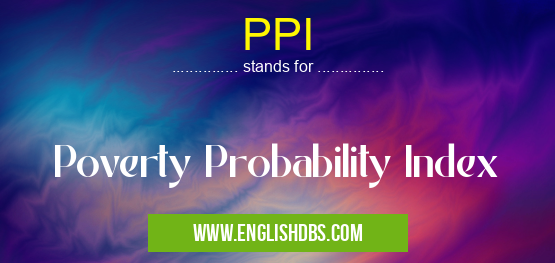What does PPI mean in UNCLASSIFIED
PPI stands for Poverty Probability Index. It is a statistical measure used to estimate the likelihood of a person or household living in poverty. The PPI is calculated using a combination of demographic, economic, and social factors, such as:

PPI meaning in Unclassified in Miscellaneous
PPI mostly used in an acronym Unclassified in Category Miscellaneous that means Poverty Probability Index
Shorthand: PPI,
Full Form: Poverty Probability Index
For more information of "Poverty Probability Index", see the section below.
PPI: Meaning and Explanation
- Age
- Income
- Education level
- Employment status
- Household size
- Geographic location
The PPI is often used by government agencies, researchers, and social service organizations to identify areas and populations that are at risk of poverty.
Uses of PPI
- Targeted interventions: The PPI can help policymakers and social service providers identify areas and populations that need targeted poverty reduction programs.
- Monitoring progress: The PPI can be used to track progress in reducing poverty over time.
- Research: The PPI can help researchers understand the factors that contribute to poverty and develop effective interventions.
Essential Questions and Answers on Poverty Probability Index in "MISCELLANEOUS»UNFILED"
What is the Poverty Probability Index (PPI)?
The PPI is a measure that estimates the likelihood of a person or household living in poverty. It is calculated using various sociodemographic and economic factors, such as income, education, household composition, and location.
How is the PPI used?
The PPI can be used by policymakers, researchers, and social service organizations to identify individuals and families at risk of poverty. It can also be used to evaluate the effectiveness of anti-poverty programs and to inform policy decisions.
What are the limitations of the PPI?
Like any statistical measure, the PPI has certain limitations. It is based on a statistical model and may not accurately predict poverty status for all individuals or households. Additionally, the factors used to calculate the PPI may not fully capture all aspects of poverty.
How can I access my PPI?
The PPI is not typically available for individuals to access. It is primarily used by researchers and policymakers for statistical analysis and policy development.
Is the PPI the same as the poverty line?
No. The poverty line is a specific income threshold used to determine whether an individual or household is considered poor. The PPI, on the other hand, is a probabilistic measure that estimates the likelihood of poverty.
How often is the PPI updated?
The PPI is typically calculated using data from the American Community Survey (ACS), which is conducted by the U.S. Census Bureau. The ACS is a large-scale survey that collects data on various socioeconomic characteristics of the U.S. population. The PPI is updated annually based on the most recent ACS data.
Final Words: The Poverty Probability Index (PPI) is a valuable tool for identifying and addressing poverty. By understanding the factors that contribute to poverty, we can develop more effective strategies to reduce its impact on individuals and communities.
PPI also stands for: |
|
| All stands for PPI |
